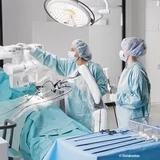The Japanese Phoenix rising

It would be hard to think of robots without thinking of Japan.
The Land of the Rising Sun has been a pioneer of industrial robotics since the late 1960s. Today, it is believed that more than half of the world’s industrial robots were made in Japan. Meanwhile, Japan has also made the robot a hero of its popular culture, which in turn has also been widely exported.
Nevertheless, the historic leader stayed absent for a long time from the booming market of robotic-assisted surgical systems. It wasn’t until December 2020 that the very first “Made in Japan” robot was launched on the market. It was the hinotoriTM (phoenix in Japanese), surgical robot by Medicaroid.
Following the market introduction, Kobe University announced that the first prostatectomy using hinotori was successfully performed at Kobe University Hospital. A few months later, in April 2021, Medicaroid demonstrated telesurgery using hinotori in a medical institution fitted with state-of-the-art equipment, via NTT Docomo’s 5G network, which proved the concept of remote surgery.
Much of these successes go back to the company’s origins. Medicaroid was established in 2013 as a joint venture between two giants, Kawasaki Heavy Industries (KHI), manufacturer of the first Japanese industrial robot and industry leader, and Sysmex, a haematology specialist and a leader in the Japanese healthcare industry for the past 50 years, providing services in approximately 200 countries.
Today, Medicaroid employs a staff of over 100, including KHI engineers and Sysmex service staff.
Telesurgery will be developed in the future, but for the time being, hinotori has been used in the same operating room where the patient is installed. Medicaroid confirms that, thanks to its compact size, the system fits in a standard operating theatre.
The armrest height, the foot pedal depth and the angle of the 3D viewer are adjustable to fit individual postures and reduce fatigue, “even during lengthy surgical operations.” Surgeons can visualise the operating field in 3D high-resolution images. Integrated microphones and loudspeakers make it possible to communicate effortlessly with the surgical team.
According to Medicaroid, the greatest technological challenge was to capture and reproduce the surgeons’ movements and gestures. Medicaroid involved the surgeons in the development project since the early stages, using their feedback and advice to shape the design. “Eventually, we were able to complete a robot that can reproduce the movements of the surgeons’ hands.”

Meet Hinotori
Surgeons do not want robots to perform surgery. They want the robots to fully replicate their own surgical skills.
To perform such precise tasks, hinotori’s arms are articulated around 8 axes. They are compact, human-sized arms, a design chosen to reduce interference between them and the bedside assistants.
Hinotori is only an assistant in surgery, insists Medicaroid. This was the guiding principle of every aspect of its design. “Surgeons do not want robots to perform surgery. They want the robots to fully replicate their own surgical skills.” This affirms Medicaroid’s vision on robotics in general: the ideal robot is one that coexists with humans, serves humans, and extends the ability of humans.
Hinotori is equipped with six instruments and can be used for five different urology procedures, covered by insurance in Japan only. It is of course just the beginning, since the robot can operate in other minimally invasive surgical fields as well. Last November, Medicaroid filed an application for regulatory approval of the use of hinotori in gynaecology and gastroenterology in Japan.
Further application fields will follow. Since 2018, fourteen surgical fields have been approved for health insurance coverage in Japan. Therefore, hinotori’s progress on the Japanese market seems to be assured. Moreover, if everything goes as planned, Medicaroid’s phoenix of surgical robotics should soon be rising beyond its borders.

